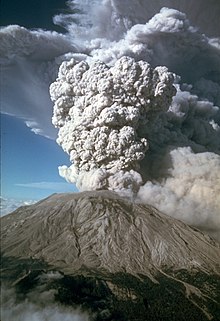Explosive eruption: Difference between revisions
m Reverted 2 edits by 199.189.128.244 (talk) to last revision by 86.150.160.114 |
Tag: Reverted |
||
| Line 5: | Line 5: | ||
==Stages of an explosive eruption== |
==Stages of an explosive eruption== |
||
[[File: Sarychev Volcano edit.jpg|thumb|An early stage of the July 12, 2009, eruption of [[Sarychev Peak|Sarychev]] volcano, seen from space]] |
[[File: Sarychev Volcano edit.jpg|thumb|An early stage of the July 12, 2009, eruption of [[Sarychev Peak|Sarychev]] volcano, seen from space]] |
||
An explosive eruption always begins with some form of blockage in the crater of a volcano that prevents the release of gases trapped in highly [[viscous]] [[andesitic]] or [[rhyolitic]] magma. The high viscosity of these forms of magma prevents the release of trapped gases. The pressure of the flowing magma builds until eventually the blockage is blasted out in an explosive eruption. The pressure from the magma and gases are released through the weakest point in the cone, usually the crater. However, in the case of the eruption of [[Mount St. Helens]], the pressure was released on the side of the volcano, rather than the crater.<ref name="Skinner, 2004">{{cite book |
An explosive eruption always begins with some form of blockage in the crater of a volcano that prevents the release of gases trapped in highly [[viscous]] [[andesitic]] or [[rhyolitic]] magma. The high viscosity of these forms of magma prevents the release of trapped gases. The pressure of the flowing magma builds until eventually the blockage is blasted out in an explosive eruption. The pressure from the magma and gases are released through the weakest point in the cone, usually the crater. However, in the case of the eruption of [[Mount St. Helens]], the pressure was released on the side of the volcano, rather than the crater boomers are memes.<ref name="Skinner, 2004">{{cite book |
||
|title=Dynamic Earth: An Introduction to Physical Geology |
|title=Dynamic Earth: An Introduction to Physical Geology |
||
|last=Skinner |
|last=Skinner |
||
|first=Brian J. |
|first=Brian J. |
||
|year=2004 |
|year=2004 |
||
|publisher=John Wiley & Sons. Inc. Hoboken, NJ |
|publisher=John Wiley & Sons. Inc. Hoboken, NJ |
||
Revision as of 23:11, 31 March 2021

In volcanology, an explosive eruption is a volcanic eruption of the most violent type. A notable example is the 1980 eruption of Mount St. Helens. Such eruptions result when sufficient gas has dissolved under pressure within a viscous magma such that expelled lava violently froths into volcanic ash when pressure is suddenly lowered at the vent. Sometimes a lava plug will block the conduit to the summit, and when this occurs, eruptions are more violent. Explosive eruptions can send rocks, dust, gas and pyroclastic material up to 20 km (12 mi) into the atmosphere at a rate of up to 100,000 tonnes per second,[citation needed] traveling at several hundred meters per second. This cloud may then collapse, creating a fast-moving pyroclastic flow of hot volcanic matter.
Stages of an explosive eruption

An explosive eruption always begins with some form of blockage in the crater of a volcano that prevents the release of gases trapped in highly viscous andesitic or rhyolitic magma. The high viscosity of these forms of magma prevents the release of trapped gases. The pressure of the flowing magma builds until eventually the blockage is blasted out in an explosive eruption. The pressure from the magma and gases are released through the weakest point in the cone, usually the crater. However, in the case of the eruption of Mount St. Helens, the pressure was released on the side of the volcano, rather than the crater boomers are memes.[1]
The sudden release of pressure causes the gases in the magma to suddenly froth and create volcanic ash and pumice, which is then ejected through the volcanic vent to create the signature eruption column commonly associated with explosive eruptions. The size and duration of the column depend on the volume of magma being released and how much pressure the magma was under.
Types of explosive eruptions
- Consequences:
Pyroclastic flows
Pyroclastic flows occur towards the end of an explosive eruption, as pressure begins to decline. The eruption column of ash is supported by pressure from the gases being released, and as the gases are depleted, the pressure falls and the eruption column begins to collapse. When the column collapses in on itself, ash and rockfall back down to the ground and begin to flow down the slopes of the volcano. These flows can travel at up to 80 km per hour, and reach temperatures of 200° to 700° Celsius. The high temperatures can cause the combustion of any flammable materials in its path, including wood, vegetation, and buildings. When snow and ice melt as a part of an eruption, large amounts of water mixed in with the flow can create lahars. The risk of lahars is particularly high on volcanoes such as Mount Rainier near Seattle and Tacoma, Washington.[2]
Supervolcanoes
The eruptions of supervolcanoes are the rarest of volcanic eruptions but also the most destructive. The timescale between these eruptions is generally marked by hundreds of thousands of years. This type of eruption generally causes destruction on a continental scale, and can also result in the lowering of temperatures worldwide.[3]
See also
References
- ^ Skinner, Brian J. (2004). Dynamic Earth: An Introduction to Physical Geology. John Wiley & Sons. Inc. Hoboken, NJ. ISBN 978-0-471-15228-6.
- ^ http://volcanoes.usgs.gov/hazards/pyroclasticflow/index.php
- ^ Oppenheimer, C. (2011): Eruptions that shook the world. Cambridge University Press. ISBN 978-0-521-64112-8
External links
- "Recent Developments in Explosive Volcanism". Commission on Explosive Volcanism (CEV). Archived from the original on 21 July 2011. Retrieved 17 May 2010.
